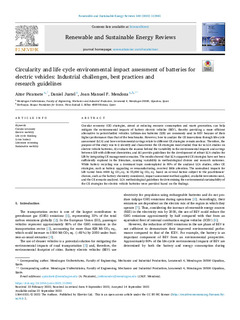| dc.rights.license | Attribution-NonCommercial 4.0 International | * |
| dc.contributor.author | Picatoste, Aitor | |
| dc.contributor.author | Justel Lozano, Daniel | |
| dc.contributor.author | Fernandez Mendoza, Joan Manuel | |
| dc.date.accessioned | 2022-11-23T10:44:20Z | |
| dc.date.available | 2022-11-23T10:44:20Z | |
| dc.date.issued | 2022 | |
| dc.identifier.issn | 1364-0321 | en |
| dc.identifier.other | https://katalogoa.mondragon.edu/janium-bin/janium_login_opac.pl?find&ficha_no=168587 | en |
| dc.identifier.uri | https://hdl.handle.net/20.500.11984/5880 | |
| dc.description.abstract | Circular economy (CE) strategies, aimed at reducing resource consumption and waste generation, can help mitigate the environmental impacts of battery electric vehicles (BEV), thereby providing a more efficient alternative to petrol-fuelled vehicles. Lithium-ion batteries (LIB) are commonly used in BEV because of their higher performance than that of the benchmarks. However, how to analyse the CE innovations through life-cycle assessment (LCA) and how environmental savings relate to different CE strategies remain unclear. Therefore, the purpose of this study was to i) identify and characterise the CE strategies most studied thus far in LCA studies on electric vehicle batteries, ii) evaluate the reasons behind the variability in the environmental impacts and savings between LIB with different chemistries, and iii) provide guidelines for the development of robust LCA studies for LIB by integrating CE management scenarios. The results showed that LCA-supported CE strategies have not been sufficiently explored in the literature, causing variability in methodological choices and research outcomes. While battery recycling was a dominant topic contemplated in 80% of the analysed LCA studies, other CE strategies, such as battery upgrading or remanufacturing, received little attention. The normalised impacts for LIB varied from 4400 kg CO2 eq. to 55,000 kg CO2 eq. based on several factors subject to the practitioners’ choices, such as the battery chemistry considered, impact assessment method applied, available inventories used, and the CE scenario analysed. LCA methodological guidelines for determining the environmental sustainability of the CE strategies for electric vehicle batteries were provided based on the findings. | en |
| dc.description.sponsorship | Comisión Europea | es |
| dc.language.iso | eng | en |
| dc.publisher | Elsevier | en |
| dc.rights | © 2022 The Authors | en |
| dc.rights.uri | http://creativecommons.org/licenses/by-nc/4.0/ | * |
| dc.subject | Circular economy | en |
| dc.subject | Electric mobility | en |
| dc.subject | Life cycle thinking | en |
| dc.subject | Li-ion battery | en |
| dc.subject | Literature screening | en |
| dc.subject | Sustainable mobility | en |
| dc.title | Circularity and life cycle environmental impact assessment of batteries for electric vehicles: Industrial challenges, best practices and research guidelines | en |
| dc.type | http://purl.org/coar/resource_type/c_6501 | |
| dcterms.accessRights | http://purl.org/coar/access_right/c_abf2 | en |
| dcterms.source | Renewable and Sustainable Energy Reviews | en |
| local.contributor.group | Economía Circular y Sostenibilidad Industrial | es |
| local.description.peerreviewed | true | en |
| local.identifier.doi | https://doi.org/10.1016/j.rser.2022.112941 | en |
| local.relation.projectID | info:eu-repo/grantAgreement/EC/H2020/963522/EU/Lightweight Battery System for Extended Range at Improved Safety/LIBERTY | en |
| local.source.details | Vol. 169. November, 2022 | en |
| oaire.format.mimetype | application/pdf | |
| oaire.file | $DSPACE\assetstore | |
| oaire.resourceType | http://purl.org/coar/resource_type/c_6501 | en |
| oaire.version | http://purl.org/coar/version/c_970fb48d4fbd8a85 | en |








